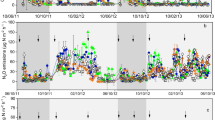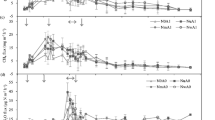Abstract
Aim
There is an ongoing discussion of potential effect of controlled-release fertilizer (CRF) on nitrous oxide (N2O) emission from paddy fields.
Method
A four-year field experiment was launched in a major rice cultivation region of China in 2008 and completed in 2011 to explore effects of CRF on N2O emissions from paddy fields. The experimental field followed a water regime pattern typical of China, that is, flooding, mid-season aeration (MSA), reflooding and drying-wetting alternation in sequence. Three treatments, i.e.Treatment CK (no N-fertilizer applied), Treatment U (urea applied), and Treatment C (CRF applied), were laid out in a randomized block design.
Results
Over the 4 years, the estimated average of N2O emissions during the rice seasons were 19.5 ± 5.5, 81.4 ± 17.8 and 69.6 ± 18.7 mg N m−2 in Treatments CK, U and C, respectively. On average, CRF reduced N2O emissions by 13 % and grain yields by 5 %, too, when compared to urea. With normal MSA, Treatment C was 50 %, 11 %, and 25 % lower in N2O emission than Treatment U in 2009, 2010 and 2011 N (N normal aeration) (p < 0.05), respectively, while the former was 31 % higher (p < 0.05) in 2008 and 7 % lower (p > 0.05) in 2011D (D delayed aeration) than the latter with delayed MSA.
Conclusions
CRF inhibited not only the N2O concentration trapped in the soil pore-water but also the production of N2O during the MSA period. Timing of MSA affected the efficiency of CRF mitigating N2O from the paddy field. The findings suggest that MSA starting around D30 (30 days after rice transplanting), the way the local farmers do, would optimize the effect of CRF mitigating N2O from rice fields in China. However, optimization of rice yield using CRF requires further research.






Similar content being viewed by others
References
Akiyama H, Yan XY, Yagi K (2010) Evaluation of effectiveness of enhanced-efficiency fertilizers as mitigation options for N2O and NO emissions from agricultural soils: meta-analysis. Global Chang Biol 16:1837–1846
Ardell DH, Stephen JD, Francesco A (2010) Tillage and inorganic nitrogen source effects on nitrous oxide emissions from irrigated cropping systems. Soil Sci Soc Am J 74(2):436–445
Beauchamp EG (1997) Nitrous oxide emission from agricultural soils. Can J Soil Sci 77:113–123
Bouwman AF (1990) Soils and the greenhouse effect. John Wiley and Sons, New York
Cai ZC, Xing GX, Yan XY, Xu H, Tsuruta H, Yagi K, Minami K (1997) Methane and nitrous oxide emissions from rice paddy fields as affected by nitrogen fertilizers and water management. Plant Soil 196:7–14
Cai ZC, Xing GX, Shen G, Xu H, Yan XY, Tsuruta H, Yagi K, Minami K (1999) Measurements of CH4 and N2O emissions from rice paddies in Fengqiu, China. Soil Sci Plant Nutr 45:1–13
Cassman KG, Peng S, Olks DC, Ladha JK, Reichardt W, Dobermann A, Singh U (1998) Opportunities for increased nitrogen-use efficiency from improved resource management in irrigated rice systems. Field Crop Res 56:7–39
Chantigny MH, Prevost D, Angers DA, Simard RR, Chalifour FP (1998) Nitrous oxide production in soils cropped to corn with varying N fertilization. Can J Soil Sci 78:589–596
Chu HY, Hosen Y, Yagi K (2004) Nitrogen oxide emissions and soil microbial activities in a Japanese andisol as affected by N-fertilizer management. Soil Sci Plant Nutr 50(2):287–292
Delgado J, Mosier A (1996) Mitigation alternatives to decrease nitrous oxides emissions and urea-nitrogen loss and their effect on methane flux. J Environ Qual 25:1105–1111
Dobbie KE, Smith KA (2003) Nitrous oxide emission factors for agricultural soils in Great Britain: the impact of soil water filled pore space and other controlling variables. Global Chang Biol 9(2):204–218
Dong HB, Yao ZS, Zheng XH, Mei BL, Xie BH, Wang R, Deng J, Cui F, Zhu JG (2011) Effect of ammonium-based, non-sulfate fertilizers on CH4 emissions from a paddy field with a typical Chinese water management regime. Atmos Environ 45:1095–1101
Duan LL, Zhang M, Liu G, Shang ZC, Yang Y (2009) Nutrient release characteristics and use efficiency of slow- and controlled release fertilizers. Chin J Appl Ecol 20(5):1118–1124 (In Chinese)
Freney JR, Denmead OT (1992) Factors controlling ammonia and nitrous oxide emission from flooded rice fields. Ecol Bull 42:188–194
Granli T and Bockman OC (1994) Nitrous oxide from agriculture. Nor J Agric Sci Supplement No. 12:34–40
Grant C (2005) Policy aspects related to the use of enhanced-efficiency fertilizers: viewpoint of the scientific community. In: Moiser A, Galloway J (eds) IFA international workshop on enhanced-efficiency fertilizers. International Fertilizer Association, Frankfurt, pp 1–11, Available at http://www.fertilizer.org/ifa/Home-page/LIBRARY/Conference-proceedings/Agricuture-Conferences/2005-IFA-Agricuture-Workshop. Accessed 10 Mar 2012
Hadi A, Inubushi K, Yagi K (2010) Effect of water management on greenhouse gas emissions and microbial properties of paddy soils in Japan and Indonesia. Paddy Water Environ. doi:10.1007/s1033-010-0210-x
International Rice Research Institute (IRRI) (2004) RiceStat Database, Los Baños, Philippines. http://www.irri.org/science/ricestat/index.asp Accessed 10 Mar 2012
IPCC (2001) Climate change 2001:the physical scientific basis. Contribution of working group to the third assessment report of the IPCC. Cambridge University Press, Cambridge
IPCC(2007) Climate change 2007: Understanding and Attributing Climate Change. http://www.ipcc.ch/pdf/assessment-report/ar4/wg1/ar4-wg1-chapter9.pdf. Accessed 10 Mar 2012
Isermann K (1994) Agriculture’s share in the emission of trace gases affection the climate and some cause-oriented proposals for reducing this share. Environ Pollut 83:95–111
Jarosiewicz A, Tomaszewska M (2003) Controlled-release NPK fertilizer encapsulated by polymeric membranes. J Agric Food Chem 51(2):413–417
Ji Y, Liu G, Ma J, Xu H, Yagi K (2012) Effect of controlled-release fertilizer on nitrous oxide emission from a winter wheat field. Nutr Cycl Agroecosyst 94(1):111–122
Kiran JK, Khanif YM, Amminuddin H, Anuar AR (2010) Effects of controlled release urea on the yield and nitrogen nutrition of flooded rice. Commun Soil Sci Plant Anal 41(7):811–819
Li X, Inubushi K, Sakamota K (2002) Nitrous oxide concentrations in an Andisol profile and emissions to the atmosphere as influenced by the application of nitrogen fertilizers and manure. Biol Fertil Soils 35:108–113
Li FM, Fan XL, Liu F, Wang Q (2004) Effects of controlled release fertilizers on N2O emission from paddy field. Chin J Appl Ecol 15(11):2170–2174 (in Chinese)
Li XL, Zhang XY, Xu H, Cai ZC, Yagi K (2009) Methane and nitrous oxide emissions from rice paddy soil as influenced by timing of application of hydroquinone and dicyandiamide. Nutr Cycl Agroecosyst. doi:10.1007/s10705-008-9246-3
Li XL, Yuan WP, Xu H, Cai ZC, Yagi K (2011) Effect of timing and duration of midseason aeration on CH4 and N2O emissions from irrigated lowland rice paddies in China. Nutr Cycl Agroecosyst 91:293–305
Ma J, Ma ED, Xu H, Yagi K, Cai ZC (2009) Wheat straw management affects CH4 and N2O emissions from rice fields. Soil Biol Biochem 41(5):1022–1028
Mctaggart IP, Tsuruta H (2003) The influence of controlled release fertilizers and the form of applied fertilizer nitrogen on nitrous oxide emission from an andosol. Nutr Cycl Agroecosyst 67(1):47–54
Mosier AR, Kroese C (2000) Potential impact on the global atmospheric N2O budget of the increased Nitrogen input required to meet future global food demands. Chemosphere Global Change Sci : 465–473
Mosier AR, Wassmann R, Verchot L, King J, Palm C (2004) Methane and nitrous oxide fluxes in tropical agricultural soils: sources, sinks, and mechanisms. Environ Dev Sustain 6:11–49
Peng SZ, Yang SH, Xu JZ, Luo YF, Hou HJ (2011a) Nitrogen and phosphorus leaching losses from paddy fields with different water and nitrogen managements. Paddy Water Environ 9:333–342
Peng SZ, Hou HJ, Xu JZ, Mao Z, Abudu S, Luo YF (2011b) Nitrous oxide emissions from paddy fields under different water managements in southeast China. Paddy Water Environ 9(3):403–411
Shaviv A (2001) Advances in controlled-release fertilizers. Adv Agron 71:1–49
Shoji S, Kanno H (1994) Use of polyolefin-coated fertilizers for increasing fertilizer efficiency and reducing nitrate leaching and nitrous oxide emissions. Fert Res 39:147–152
Shoji S, Delgado J, Moiser A (2001) Use of controlled release fertilizers and nitrification inhibitors to increase nitrogen use efficiency and to conserve air and water quality. Commun Soil Sci Plant Anal 32(7&8):1051–1070
Smith KA, McTaggart IP, Dobbie KE, Conen F (1998a) Emissions of N2O from Scottish agricultural soils, as a function of fertilizer N. Nutr Cycl Agroecosyst 53:123–130
Smith KA, Thomson PE, Clayton H, McTaggart IP, Conen F (1998b) Effect of temperature, water content and nitrogen fertilization on emissions of nitrous oxide by soils. Atmos Environ 32:3301–3309
Soil Survey Staff (1975) Soil taxonomy. U.S. Department of Agriculture Handbook, No. 436. USDA, Washington, DC
Towprayoon S, Smakgahn K, Poonkaew S (2005) Mitigation of methane and nitrous oxide emissions from drained irrigated rice fields. Chemosphere 59:1547–1556
Venterea RT, Rolston DE (2000) Mechanisms and kinetics of nitric and nitrous oxide production during nitrification in agricultural soil. Glob Chang Biol 6:303–316
Wassmann R, Buendia LV, Latin RS, Bueno CS, Lubigan LA, Umali A, Nocon NN, Javellana AM, Neue HU (2000) Mechanisms of crop management impact on methane emissions from rice fields in LosBaños, Philippines. Nutr Cycl Agroecosyst 58:107–119
Xing GX, Yan XY (1999) Direct nitrous oxide emissions from agricultural fields in China estimated by the revised 1996 IPCC guidelines for national greenhouses gases. Environ Sci Pol 2:355–361
Xing G, Zhu Z (1997) Preliminary studies on N2O emission fluxes from upland soils and paddy soils in China. Nutr Cycl Agroecosyst 49:17–22
Xu H, Xing GX, Cai ZC, Tsuruta H (1997) Nitrous oxide emissions from three rice paddy fields in China. Nutr Cycl Agroecosyst 49:23–28
Xu H, Cai ZC, Li XP, Tsurutal H (2000) Effect of antecedent soil water regime and rice straw application time on CH4 emission from rice cultivation. Aust J Soil Res 38:1–12
Xu H, Cai ZC, Tsuruta H (2003) Soil moisture between rice-growing seasons affects methane emission, production, and oxidation. Soil Sci Soc Am J 67:1147–1157
Yagi K, Tsuruta H, Kanda K, Minami K (1996) Effect of water management on methane emission from a Japanese rice paddy field: automated methane monitoring. Glob Biogeochem Cycles 10(2):255–267
Yan XY, Du L, Shi S, Xing GX (2000) Nitrous oxide emission from wetland rice soil as affected by the application of controlled-availability fertilizers and mid-season aeration. Biol Fertil Soils 32:60–66
Yan XY, Akimoto H, Ohara T (2003a) Estimation of nitrous oxide, nitric oxide and ammonia emissions from croplands in East, Southeast and South Asia. Glob Chang Biol 9:1080–1096
Yan XY, Cai ZC, Ohara T, Akimoto H (2003b) Methane emission from rice fields in mainland China: amount and seasonal and spatial distribution. J Geophys Res 108(D16):4505. doi:10.1029/2002JD003182
Yan XY, Yagi K, Akiyama H, Akimoto H (2005) Statistical analysis of the major variables controlling methane emission from rice fields. Glob Chang Biol 11:1131–1141
Yao ZS, Zheng XH, Xie BH, Liu CY, Mei BL, Dong HB, Butterbach K, Zhu JG (2009) Comparison of manual and automated chambers for field measurements of N2O, CH4, CO2 fluxes from cultivated land. Atmos Environ 43:1888–1896
Zheng XH, Wang MX, Wang YS, Shen RX, Gou J, Li J, Jin JS, Li LT (2000) Impacts of soil moisture on nitrous oxide emission from croplands: a case study on the rice-based agro-ecosystem in Southeast China. Chemosphere Global Change Sci 2:207–224
Acknowledgments
Funding for this research work was provided by Ministry of Science and Technology of China (S2012GR0080), Chinese Academy of Sciences (XDA05020200), Ministry of Agriculture of China (201103039), and the National Natural Sciences Foundation of China (Grant No. 40971154). The authors would like to express their thanks to the responsible editors and anonymous reviewers for their corrections and suggestions to the manuscript.
Author information
Authors and Affiliations
Corresponding author
Additional information
Responsible Editor: Catherine Henault.
Rights and permissions
About this article
Cite this article
Ji, Y., Liu, G., Ma, J. et al. Effect of controlled-release fertilizer on mitigation of N2O emission from paddy field in South China: a multi-year field observation. Plant Soil 371, 473–486 (2013). https://doi.org/10.1007/s11104-013-1700-6
Received:
Accepted:
Published:
Issue Date:
DOI: https://doi.org/10.1007/s11104-013-1700-6




